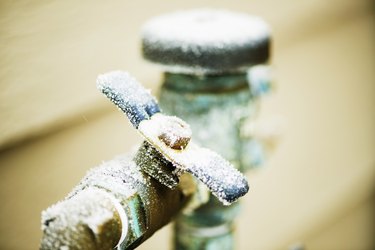Tips to Maintain Your Pipes from Freezing Damage: Important Tips
Tips to Maintain Your Pipes from Freezing Damage: Important Tips
Blog Article
Nearly everybody maintains their private thinking about Winter Plumbing Precautions: Preventing Frozen Pipes.

Cold weather can damage your plumbing, specifically by freezing pipelines. Here's how to avoid it from taking place and what to do if it does.
Intro
As temperatures decline, the threat of frozen pipelines rises, possibly bring about pricey repairs and water damage. Understanding how to prevent frozen pipelines is crucial for homeowners in cool environments.
Avoidance Tips
Insulating prone pipes
Wrap pipelines in insulation sleeves or utilize warm tape to shield them from freezing temperature levels. Concentrate on pipes in unheated or external locations of the home.
Home heating methods
Keep indoor rooms sufficiently heated up, specifically areas with plumbing. Open up cabinet doors to allow warm air to distribute around pipelines under sinks.
Just how to identify icy pipelines
Seek lowered water circulation from faucets, unusual odors or noises from pipelines, and visible frost on exposed pipes.
Long-Term Solutions
Architectural modifications
Take into consideration rerouting pipes far from exterior walls or unheated locations. Include additional insulation to attics, basements, and crawl spaces.
Upgrading insulation
Invest in premium insulation for pipes, attics, and walls. Proper insulation aids preserve constant temperatures and decreases the threat of icy pipelines.
Shielding Exterior Plumbing
Garden tubes and exterior taps
Detach and drain pipes garden pipes prior to winter months. Mount frost-proof spigots or cover outdoor faucets with insulated caps.
Understanding Icy Pipes
What creates pipes to ice up?
Pipes ice up when exposed to temperature levels below 32 ° F (0 ° C) for prolonged durations. As water inside the pipelines freezes, it increases, taxing the pipe walls and potentially creating them to rupture.
Risks and damages
Frozen pipes can lead to water disturbances, residential or commercial property damages, and pricey repair services. Burst pipes can flood homes and cause comprehensive structural damage.
Signs of Frozen Pipeline
Determining frozen pipelines early can stop them from bursting.
What to Do If Your Pipes Freeze
Immediate activities to take
If you think icy pipelines, maintain taps open up to relieve pressure as the ice thaws. Utilize a hairdryer or towels taken in warm water to thaw pipelines slowly.
Conclusion
Preventing icy pipelines requires positive actions and quick actions. By comprehending the reasons, indications, and preventive measures, property owners can shield their pipes throughout winter.
6 Proven Ways to Prevent Frozen Pipes and Protect Your Home
Disconnect and Drain Garden Hoses
Before winter arrives, start by disconnecting your garden hoses and draining any remaining water. Close the shut-off valves that supply outdoor hose bibs and leave the outdoor faucet open to allow any residual water to drain. For extra protection, consider using faucet covers throughout the colder months. It’s also important to drain water from any sprinkler supply lines following the manufacturer’s directions.
Insulate Exposed Pipes
Insulating your pipes is an effective way to prevent freezing. Pipe insulation is readily available at home improvement stores and is relatively inexpensive. Pay close attention to pipes in unheated areas such as the attic, basement, crawl spaces, or garage. Apply foam insulation generously to create a buffer against the cold. You can also wrap your pipes in heat tape or thermostat-controlled heat cables for added warmth.
Seal Air Leaks
Inspect your home for any cracks or openings that could let in cold air. Seal any holes around the piping in interior or exterior walls, as well as the sill plates where your home rests on its foundation. Additionally, make sure to keep your garage door closed unless you’re entering or exiting. Leaving it open creates a significant air leak that can lead to frozen pipes.
Allow Warm Air Circulation
During cold snaps, it’s essential to allow warm air to circulate evenly throughout your home. Leave interior doors ajar to promote better airflow. Open kitchen and bathroom cabinets to help distribute heat consistently around the rooms. If you have small children or pets, be sure to remove any household chemicals or potentially harmful cleaners from open cabinets for safety.
Let Faucets Drip
A small trickle of water can make a big difference in preventing ice formation inside your pipes. When temperatures drop significantly, start a drip of water from all faucets served by exposed pipes. This continuous flow helps prevent the water from freezing. Additionally, running a few faucets slightly can relieve pressure inside the pipes, reducing the chances of a rupture if the water inside does freeze.
https://choateshvac.com/6-proven-ways-to-prevent-frozen-pipes-and-protect-your-home/

I am just very fascinated with How To Avoid Freezing Pipes and I'm hoping you enjoyed reading the entire page. Do you know about another individual who is intrigued by the subject? Take a moment to promote it. Many thanks for taking the time to read it.
Free Estimates Report this page